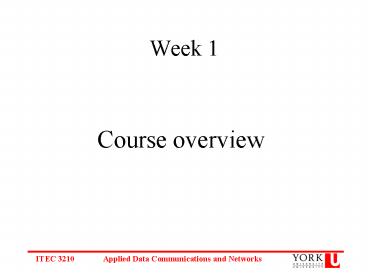Week 1 - PowerPoint PPT Presentation
1 / 15
Title:
Week 1
Description:
Communication occurs: Between different layers on the same system ... messages from one network to another (no direct relationship between sender and receiver) ... – PowerPoint PPT presentation
Number of Views:39
Avg rating:3.0/5.0
Title: Week 1
1
Week 1
- Course overview
2
Learning objectives
- Network basics
- A classification
- The component view
- The layer view
- Performance
- Office networks Importance and related jobs
- Network analysis design Content, process
challenges - Application exercise
3
Networks
- Group of computers or other devices connected by
some type of transmission media - Can be small or large LAN, MAN, WAN, BBN
- ? Structured design (see next slide)
- Internet, intranet and extranet Whats the major
difference between the three? - Two possible views
- The component view
- The layer view
4
Structured Design aka BBN architecture
- Block 1 The access layer connects nodes to a LAN
- Block 2 The distribution layer is the BBN that
inter connects LANs - Block 3 The core layer is the BBN that
interconnects different BBNs (Block 3 is found in
large organizations only) - ? This architecture is aka structured design
5
Components of Networks
- Hardware
- Computers
- Mainframes, servers, workstations, personal
computers, terminals, etc. - Architectures Clients/servers peer-to-peer
networks mainframe/terminals - Different types of servers and different types
of clients - Connectivity devices
- To form a LAN NIC, switch
- To interconnect LANs Switch, router, gateway,
bridge - Transmission media (AKA circuits) guided versus
wireless - Other Repeaters, printers, connectors, storage
devices - Software
- Application software
- Network Operating Systems
- Protocols (See next slide)
- Agreed upon rules for transmitting data between 2
devices - Some of these rules are handled by hardware
(physical layer)
6
Multi-layer view of networks
- Models that reduce the complexity of data
communication between computers - Modular approach
- The process of transferring data is divided into
layers - Each layer handles specific sub-tasks with
specific protocols - Communication occurs
- Between different layers on the same system
- Between similar layers on different systems
- See slide 11
7
OSI and course overview
8
Application Layers
- Handle the users connection to the network
- Include
- 7. Application Allows 2 application programs on
separate computers to work together (HTTP, SMTP,
SNMP) - 6. Presentation Formats data for presentation to
user (translation between data formats,
encryption, compression) - 5. Session Initiates, maintains and terminates
each session between sender and receiver
(synchronizes transmission and restarts it in
case of interruption)
9
Internetwork Layers
- Move messages from one network to another (no
direct relationship between sender and receiver) - Include
- 4. Transport Segments message if necessary and
ensures that all segments have been received and
in sequence - 3. Network Makes routing decisions
10
Hardware Layers
- Move messages from one computer (or device) to
another - Include
- 2. Data Link Deals with message delineation,
error control, physical addressing and network
medium access control - 1. Physical Defines how to represent individual
bits and the connectors to be used.
11
Message transmission using layersRemember Slide
6?
12
Application exercises
- 1) Why do organizations need networks?
- 2) How is the performance of networks measured?
13
Networking jobs and certifications
- Network Designer (or Architect)
- Responsibilities Architecture of networks to be
built/upgraded/expanded - Knowledge Networking basics, business needs and
products available - Certifications Cisco network designer stream
- Network (or System) Administrator
- Responsibilities Daily operations (managing
equipment trouble shooting) - Knowledge Networking basics, configuration of
NOS equipment, trouble shooting - Certifications Cisco network administration
stream Network MCSECNE - Other related jobs Database administrator, email
administrator.
14
Network challenges
- Methodologies
- Defining users needs and deciding on components
to meet the requirements for the to-be network - Performance (how is it measured?)
- Security and Maintenance
- Compatibility between equipment from different
vendors (Role of standards!)
15
Thank you































